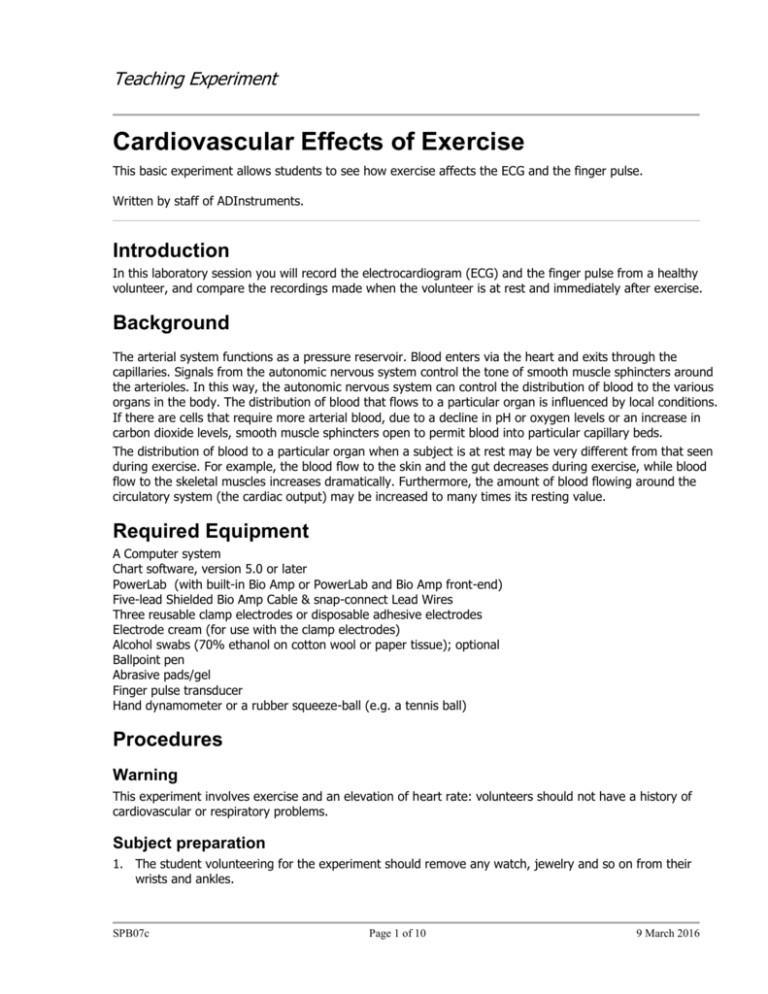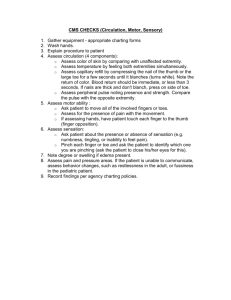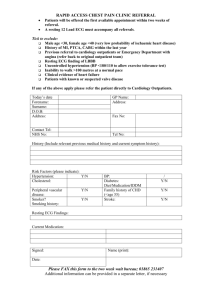
Teaching Experiment
Cardiovascular Effects of Exercise
This basic experiment allows students to see how exercise affects the ECG and the finger pulse.
Written by staff of ADInstruments.
Introduction
In this laboratory session you will record the electrocardiogram (ECG) and the finger pulse from a healthy
volunteer, and compare the recordings made when the volunteer is at rest and immediately after exercise.
Background
The arterial system functions as a pressure reservoir. Blood enters via the heart and exits through the
capillaries. Signals from the autonomic nervous system control the tone of smooth muscle sphincters around
the arterioles. In this way, the autonomic nervous system can control the distribution of blood to the various
organs in the body. The distribution of blood that flows to a particular organ is influenced by local conditions.
If there are cells that require more arterial blood, due to a decline in pH or oxygen levels or an increase in
carbon dioxide levels, smooth muscle sphincters open to permit blood into particular capillary beds.
The distribution of blood to a particular organ when a subject is at rest may be very different from that seen
during exercise. For example, the blood flow to the skin and the gut decreases during exercise, while blood
flow to the skeletal muscles increases dramatically. Furthermore, the amount of blood flowing around the
circulatory system (the cardiac output) may be increased to many times its resting value.
Required Equipment
A Computer system
Chart software, version 5.0 or later
PowerLab (with built-in Bio Amp or PowerLab and Bio Amp front-end)
Five-lead Shielded Bio Amp Cable & snap-connect Lead Wires
Three reusable clamp electrodes or disposable adhesive electrodes
Electrode cream (for use with the clamp electrodes)
Alcohol swabs (70% ethanol on cotton wool or paper tissue); optional
Ballpoint pen
Abrasive pads/gel
Finger pulse transducer
Hand dynamometer or a rubber squeeze-ball (e.g. a tennis ball)
Procedures
Warning
This experiment involves exercise and an elevation of heart rate: volunteers should not have a history of
cardiovascular or respiratory problems.
Subject preparation
1. The student volunteering for the experiment should remove any watch, jewelry and so on from their
wrists and ankles.
SPB07c
Page 1 of 10
9 March 2016
Teaching Experiment
2. Connect the BNC plug from the finger pulse transducer’s cable to the BNC socket for Input 2. Rotate the
connecting ring of the transducer plug clockwise until it locks (Figure 1).
Figure 1. Setup of equipment for this experiment, showing the connections to the PowerLab
3. Place the pressure pad of the finger pulse transducer against the distal segment (the tip) of the middle
finger of either hand of the volunteer. Use the Velcro strap to attach it firmly - neither loose nor tight.
4. Plug the Bio Amp cable into the Bio Amp socket.
5. Attach the rectangular ends of the lead wires to the Earth, CH1 NEG and CH1 POS connections on the
Bio Amp cable.
6. If alcohol swabs are available, firmly swab the skin with them in each area where electrodes will be
placed
7. Using a pen, mark each area with a small cross. Lightly abrade the skin at these areas with an abrasive
pad. This decreases the electrical resistance of the outer layer of skin and ensures good electrical
contact.
8. If you are using the reusable clamp electrodes, apply a small amount of electrode cream to the
electrodes, attach the electrodes to the subject as described below and connect the electrodes to the
leads.
9. If you are using the disposable electrodes (which have electrode gel on them already), attach the
electrodes to the subject as described below, and connect the electrodes to the leads.
SPB07c
Page 2 of 10
9 March 2016
Teaching Experiment
10. Ensure the volunteer is relaxed and sits as still as possible to minimize any signal from movement.
11. Have the volunteer place their hands in their lap for all ECG measurements.
Attaching the ECG electrodes
Standard connection: attach the positive electrode to the left wrist, the negative to the right wrist, and the
ground to the right leg. If after looking at the signal in the Bio Amplifier dialog box during the first exercise
you find that this does not produce a good signal, you can use the alternative method shown (Figure 2).
Alternative connection: attach the positive electrode to the left upper arm, the negative to the right upper
arm and the ground to either wrist (Figure 2). NOTE: Do not place the electrodes over the major muscles of
the upper arm because muscle activity interferes with the signal recorded from the heart. Attach the
electrodes on the outer side of the arm, midway between the elbow and the shoulder.
Figure 2. Attaching ECG electrodes; two alternative methods.
Software setup and calibration
Note: To set up recording for this experiment, you load a settings file from the Experiments Gallery. If your
tutor has made other arrangements, for instance, the Experiments Gallery does not contain the required
settings file, or you have to set up the file manually, then follow their instructions. Otherwise continue.
1. Locate Chart on your computer and start the program. If the Experiments Gallery dialog box does not
appear in front of the Chart window, choose the “Experiments Gallery…” command from the File menu.
2. In the Experiments Gallery dialog box, select “Cardiovascular Effects of Exercise” in the left-hand list.
Select “ECG & Pulse Settings” in the right-hand list, and click the Open button to apply those settings.
3. After a short time, the Chart window on the computer screen should be set up for the experiment.
Channel 1 should be named “Vol. Pulse”, Channel 2 “Blood Flow” and Channel 3 “ECG”.
SPB07c
Page 3 of 10
9 March 2016
Teaching Experiment
Note: Channel 2 is the raw signal from the finger pulse transducer and is an indication of the net rate of
blood flow into the finger pulp. The time integral of Channel 2 is displayed on Channel 1 and illustrates the
change in finger pulp volume over time.
You are now ready to begin the exercises.
Exercise 1: ECG and volume pulse at rest
Objectives
In this part of the lab, you will measure the ECG and volume pulse from a resting volunteer.
Procedure
Everything should be set up as described in the general notes above. Ask the volunteer to remain as relaxed
and still as possible, to minimize any signal from movement. The Bio Amp cable comes with a clip that can be
used to gather and hold the cable and leads to help keep them still.
1. Choose Bio Amplifier from the Channel 3 (ECG) Channel Function pop-up menu. Observe the signal
that appears in the dialog box.
Note: If the ECG cannot be seen, check that all three electrodes are correctly attached. If the signal is noisy
and indistinct, make sure that the volunteer is relaxed; consider using the alternative attachment positions
shown in Figure 2. If necessary, adjust the value in the Range pop-up menu of the dialog box so that the
signal occupies about a half to two thirds of the vertical axis.
2. Click OK to return to the Chart window.
3. Choose the Input Amplifier… command from the Channel 2 (Blood Flow) Channel Function pop-up menu.
Adjust the Range so that the signal occupies about a half to two thirds of full scale when the volunteer
has both hands in their lap.
4. Click OK to return to the Chart window.
5. Click Start, and record for ten seconds; add a comment to your trace called “Resting ECG and finger
pulse”.
6. Click Stop to end your recording.
7. If you are saving your files, choose Save from the File menu to save the recording. Keep the file open
for the next exercise.
Exercise 2: ECG and volume pulse after exercise
Objectives
In this part of the laboratory, you will measure the ECG and volume pulse in a volunteer at intervals after
exercise, analyze the resultant signals, and compare them with the same volunteer’s resting ECG and volume
pulse.
SPB07c
Page 4 of 10
9 March 2016
Teaching Experiment
Procedure
1. Disconnect the Bio Amp cable and the finger pulse transducer from the PowerLab. Check that the ECG
leads are not tangled; the volunteer should gather them up and hold them.
2. The volunteer should now exercise for at least two minutes: for example, two minutes of step-up
exercise, or running up four flights of stairs.
Note: Remember that the ECG leads are still attached to the electrodes, so the volunteer should exercise
carefully (so as not to break the leads or move the electrodes), but vigorously enough to elevate their heart
rate.
3. Immediately after exercise, reconnect the Bio Amp cable and the finger pulse transducer to the
PowerLab while the volunteer sits down and relaxes.
4. Click Start, and record for two minutes or until the heart and breathing rate have returned to normal.
During this time, enter a comment called “Recovery” in your trace.
5. Click Stop to end your recording.
6. If you are saving your files, choose Save from the File menu to save the recording.
Exercise 3: Volume pulse after hand exercise
Objectives
In this part of the laboratory, you will measure changes in the finger pulse in a volunteer at intervals after
hand exercise, analyze the resultant signals, and compare them with the same volunteer’s resting finger
pulse.
Procedure
1. Disconnect the ECG leads from the volunteer. (The finger pulse transducer should remain connected.)
2. If you are saving your files, choose Save from the File menu to save the recording for Exercises 1 and 2.
3. From the File menu, choose “Experiments Gallery”, and open the settings file called “Hand Exercise
Settings”.
4. Ask the volunteer to remain still and relaxed. Click the Start button and record for 20 seconds; during
this time, enter a comment called “Resting.”
5. Click the Stop button.
6. Have the volunteer grasp the hand dynamometer (or rubber squeeze-ball) in the palm of their hand to
which the finger pulse transducer is attached, and then rhythmically squeeze it for a few minutes until
their forearm muscles fatigue.
7. Stop exercising.
8. Click Start.
SPB07c
Page 5 of 10
9 March 2016
Teaching Experiment
9. Record for two minutes or until the amplitude of the finger pulse signal has attained a reasonably
constant level for one minute; during this time, enter a comment called “Recovery from hand exercise.”
10. Click Stop.
11. If you are saving your files, choose Save from the File menu to save the recording.
Analysis
Exercises 1 and 2
1. Select a short part of the resting ECG trace, containing three cardiac cycles.
2. Open the Zoom window using the Chart Toolbar menu. Your trace should resemble Figure 3.
Note: the P-R interval is the time from the start of the P wave to the start of the QRS complex. A more
logical name would be “P-Q” interval, but P-R is the traditional nomenclature.
3. Use the Marker and Waveform Cursor to make the following time measurements from the displayed
waveform, as shown in Figure 3.
P-R time interval
QRS duration
S-T time interval
T-P time interval
R-R time interval
4. Calculate the heart rate from the R-R interval.
5. Repeat the above measurements using the first “good” ECG traces immediately 30 seconds and 60
seconds after exercise.
6. Record your data in Table 1 of your Data Notebook.
SPB07c
Page 6 of 10
9 March 2016
Teaching Experiment
P-R
QRS
S-T
T-P
Figure 3. Zoom window view of an ECG recorded from an individual at rest: the various
intervals are shown.
Exercise 3
1. Look at the “Vol. Pulse” trace recorded immediately after exercise.
2. Calculate the subjects’ heart rate from the pulse data before exercise.
3. Using the pulse data, calculate heart rate 10, 30, 60 and 120 seconds after exercise.
4. Select three pulse beats from before exercise from the “Vol. Pulse” trace.
5. Open the Zoom window.
6. Place the Marker on the baseline of the waveform.
7. Use the Waveform Cursor to determine the amplitude of a pulse beat.
8. Determine the average amplitude of three pulse beats.
9. Repeat steps 4-8 for your post-exercise data at the 10, 30, 60 and 120-second time-points.
10. Fill out Table 2 in your Data Notebook.
SPB07c
Page 7 of 10
9 March 2016
Teaching Experiment
Data Notebook
Table 1. Results table for Exercises 1 and 2.
Measurement
ECG while resting
0 seconds
ECG after exercise
30 seconds
60 Seconds
P-R interval
QRS duration
S-T interval
T-P interval
R-R interval
Heart rate
Table 2. Results from Exercise 3.
Time
Resting
Heart Rate (beats per minute)
Average Pulse Amplitude (mV)
10 seconds postexercise
30 seconds postexercise
60 seconds postexercise
120 seconds postexercise
SPB07c
Page 8 of 10
9 March 2016
Teaching Experiment
Study Questions
Exercises 1 and 2
1.
What happened to the R-R interval and the heart rate after exercise?
2.
Note that the R-R interval consists of the sum of QRS, S-T, T-P and P-R. Which of these become
shorter when the heart rate increased?
3.
How is heart rate controlled by nerves?
4.
Immediately after exercise, was the amplitude of the pulse smaller or larger than in the resting period?
5.
What happened to the pulse amplitude during recovery from exercise?
6.
During exercise, blood flow in the skin and finger pulp is usually reduced by sympathetic
vasoconstrictor nerve activity. After exercise, however, skin and finger blood flow may be increased.
Why is the blood flow to extremities reduced during exercise? Why does it increase to higher than
normal levels during recovery? What other factors may influence the supply of blood to the skin and
fingers during and after exercise?
SPB07c
Page 9 of 10
9 March 2016
Teaching Experiment
7.
Changes in the cardiovascular system are only some of a number of changes that occur in the body
during and after exercise. What other physical changes did you observe in the volunteer?
Exercise 3
8.
Immediately after hand exercise, was the amplitude of the pulse smaller or larger than in the resting
period?
9.
What happened to the pulse amplitude during recovery from hand exercise?
10.
The muscles active during hand exercise are mainly in the forearm, with a few small muscles in the
hand. Would you expect blood flow to these muscles to increase during exercise?
11.
The muscle mass in one forearm is very much less than the muscle mass in the legs. During hand
exercise, would there be a great need for the body to redirect blood flow away from the gut and skin?
12.
There are no muscles in the distal segment of the fingers. Would you expect the increased muscle
blood flow in exercise to affect the finger blood flow?
Copyright © 2004 ADInstruments. All rights reserved.
MacLab and PowerLab are registered trademarks, and Chart and Scope are trademarks, of ADInstruments. Windows and the
Windows logo are either trademarks or registered trademarks of Microsoft Corporation. Macintosh and the Mac logo are either
trademarks or registered trademarks of Apple Computer, Inc. Other trademarks are the properties of their respective owners.
www.ADInstruments.com
SPB07c
Page 10 of 10
9 March 2016







